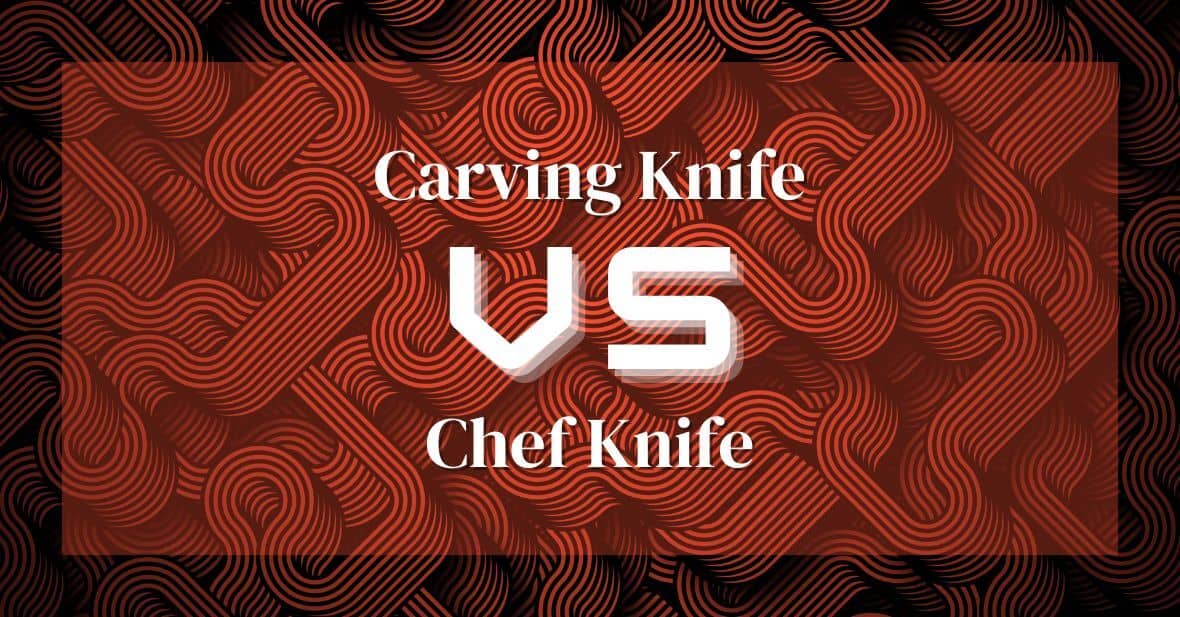Carving Knife vs Chef Knife: Carve with Precision or Master All Tasks?
Looking for the perfect kitchen knife can be a daunting task. It’s important to understand the differences between knives in order to make an informed decision. Carving knives and chef knives are two of the most popular options, but they have different strengths and weaknesses.
In this article, we’ll take a look at both types of knives and compare their features so you can pick the one that best suits your needs. It doesn’t matter if you’re slicing steak or carving a roast – having the right knife is key!
We know it can be tough to choose between a carving knife and a chef knife if you don’t have much experience with either, so we’ve put together this guide to help you out. Read on for more information about blade shapes, sizes, handles, steel types, edge retention, maintenance and more – everything you need to make an educated decision that will serve your culinary needs for years to come!
Blade Shapes and Sizes
When it comes to blade shapes and sizes, a carving knife has a thinner, more pointed shape than a chef knife’s wider, blunter design. This difference is especially noticeable when you compare the two side-by-side – the carving knife looks like an arrowhead ready to pierce whatever you want it to cut, while the chef knife looks like it could chop down trees if given the chance!
The difference in blade shape also means that each type of knife will need different chopping boards and sharpening stones for optimal use. Plus, steel types can vary between these knives too; some may have higher levels of carbon content for better durability and edge retention. All of this means that selecting the right blades for your cooking needs isn’t just about choosing between a carving or chef knife; it’s about knowing your preferences and what works best with them.
Usage and Purpose
You need to know the purpose and usage of a carving knife and a chef knife – don’t miss out!
Carving knives are designed with thin, pointed blades that allow for precision when cutting. This makes them ideal for slicing thinner items such as meat, fish, poultry, fruits, and vegetables.
Chef knives have thicker, wider blades that can handle tougher cutting techniques due to their larger surface area. They are usually used for chopping herbs and vegetables or dicing firm foods like potatoes.
Both types of knives require sharpening on a regular basis in order to perform at their best; you should always use a sharpener specifically designed for the type of blade you’re using.
Cutting techniques also play an important part when it comes to choosing between these two types of knives. If you’re looking for thin slices or delicate fillets, then a carving knife is your best bet – whereas if you want more robust cuts, then opt for the chef’s knife instead.
Edge Retention and Maintenance
Maintaining the sharpness of your blade is essential to ensure proper performance, so it’s important to pay attention to edge retention and maintenance when selecting between a carving knife and a chef knife. It comes down to personal preference, but there are some key differences between the two blades that can help you make an informed decision.
When considering edge retention and maintenance, you should take into account the type of steel used for each knife as well as any specific sharpening techniques or edge angles they employ. Here are some highlights that will help you decide:
- Carving knives are usually made from harder steel, which makes them more durable but also requires more specialized sharpening techniques like stoning or honing.
- Chef knives come in different types of steel, making it easier to find one with good edge retention while being easy enough to sharpen at home with a whetstone or electric sharpener.
- Edge angle is another factor when comparing carving vs chef knives. Most carving knives have narrower angles (10-15°) compared to chef knives (15-20°), making them sharper but also more prone to chipping or dulling faster.
Handles and Grip
When it comes to comfort and control, the handle and grip of your blade is just as important as its edge retention and maintenance. Many people think that carving knives and chef knives might have similar handles due to their overall shape, but this isn’t necessarily the case.
Carving knives typically have longer handles with more curves than their counterpart chef knives for greater comfort when making long slicing strokes. Chef’s knives usually have shorter handles that are designed for better control when cutting but may not be as comfortable if you’re doing extended work.
Additionally, the sharpness comparison between carving knives and chef’s knives can also affect the comfort level while using either type of blade. Carving knives tend to be sharper, so they require less effort, which may make them more comfortable for some users. Chef’s knives often require increased pressure in order to accomplish certain tasks, resulting in discomfort over time.
Ultimately, choosing a knife based on its handle and grip is an important factor when deciding which one best fits your needs!
Types of Steel Used
The type of steel used in a blade can play an essential role in its overall performance, affecting everything from its edge retention to its maintenance requirements. When it comes to carving knives and chef’s knives, there are two main types of steel that you’ll come across: carbon steel and stainless steel.
Carbon steel is known for having superior sharpness, but it is prone to rusting if not maintained properly.
Stainless steel, on the other hand, is not as sharp as carbon but requires less maintenance over time.
Both have their own advantages and disadvantages, so it really comes down to what your priority is when choosing the right knife for you.
Here are some key points about each type of steel:
Conclusion
You’ve learned the hard facts about carving knives and chef knives: blade sizes and shapes, usage and purpose, edge retention, and maintenance, handles, and grip, types of steel used.
Now it’s time to decide which one is right for you. Think of the carving knife as a scalpel – precise, delicate, with a sharp point that can cut through thin layers like butter.
The chef knife is more like an ax – tough, powerful, able to chop through thick chunks quickly and easily.
Both are essential tools in the kitchen – choose wisely!
Frequently Asked Questions
What Is The Best Knife For A Beginner?
Are you looking for the best knife to start your culinary adventures with? Well, look no further! A chef’s knife is perfect for a beginner because it offers great balance when dish prepping, allowing you to get a feel for working with knives without risking an injury.
What Is The Difference Between A Carving Knife And A Chef Knife?
When it comes to specialty knives, you’ll often hear people talk about carving knives and chef knives. But what’s the difference between them?
Well, a carving knife has a longer blade than a chef knife, which makes it perfect for slicing through meats and other large foods. The handle of a carving knife is also usually shaped differently than that of a chef knife, making it easier to grip when cutting.
However, when you’re just starting out in the kitchen, the best knife for you may be neither. Opt instead for something smaller and simpler like a paring or utility knife.
How Should I Store My Knife To Ensure Its Longevity?
You want your knives to last long and stay sharp—and it’s easier than you think! Proper knife maintenance starts with proper storage.
Keep your blade in a secure, dry place away from heat and moisture. If possible, use a sheath or blade guard to protect the edge of the knife when not in use.
Additionally, clean and dry the blade after each use, as accumulated dirt can cause rust and corrosion if left unattended to.
Following these simple steps will ensure that your knives remain safe and stay sharp for many years to come!
What Is The Best Way To Sharpen A Knife?
Sharpening your knife doesn’t have to be a daunting task! There are many hot sharpening techniques you can use to keep your blade in top condition.
Honing stones are one of the best and easiest ways to sharpen a knife. Not only is honing with these stones quick and effective, but they’re also relatively cost-effective and won’t take up much space in your kitchen drawers.
Plus, the satisfaction of knowing that you’ve used a centuries-old technique is worth its weight in gold! So why not give honing stones a try?
Your knife will thank you for it!
Are There Any Safety Tips To Consider When Using A Knife?
When it comes to using a knife, safety should always be top of mind. Whether you’re carving a turkey or slicing an onion, following some basic guidelines can help keep you out of harm’s way.
First and foremost, make sure you select the right knife for the job. A sharp chef’s knife is great for chopping vegetables, but if you’re dealing with something tougher like bone or frozen meat, then opt for a more rugged carving knife.
In addition to selecting the right tool for the job, proper maintenance is essential too – make sure your knives are regularly sharpened and properly stored when not in use.
Following these simple tips will have you prepping meals safely and efficiently!
Additional Resources
19 Types of Kitchen Knives & Their Uses
Western Style Knives 101 | A Comprehensive Introduction to the Basics
The Art of the Slice: A Dive into Japanese Knife Types
What Is a Chef Knife? Your Ultimate Guide to This Essential Kitchen Tool
What is a Carving Knife: Everything You Need To Know
Forging Culinary Excellence: The Best Steel For Kitchen Knives

